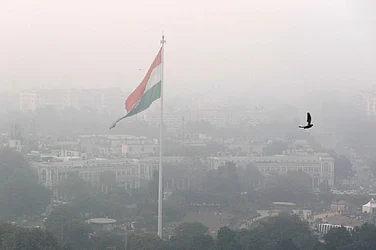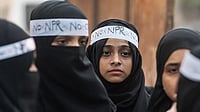The satta bazaar is seeing frenzied betting as March 10, the day results of the elections in five states will be declared. An estimated Rs 1,000 crore has so far been “invested” in the satta bazaar on the political outcomes of elections in Uttar Pradesh, Punjab, Goa, Uttarakhand and Manipur. While maximum satta bets are for UP, there are no bets being taken for Manipur, said sources in the Faludi satta bazaar in north Rajasthan, one of the largest illegal betting markets in India.
The satta bazaar predicts BJP will face losses, but will be back to rule in UP. However, Ajay Singh Bisht aka Yogi Adityanath will not be repeated as the chief minister, a punter told Outlook. The satta market rate for a change of CM in UP is at 30 paise. The BJP is expected to win 225-230 seats in UP, while the satta bazaar gives Samajwadi Party (SP) 120. Both Bahujan Samaj Party (BSP) and Congress are expected to get around 5-7 seats each.
The going satta rate for BJP getting 230 seats is 40 paise, 235 seats is Rs 1.20 and 240 seats is Rs 1.70. In the satta bazaar, those with lower rates on them stand a higher chance of winning. Higher bets indicate lower chances of victory. The rate for SP getting 120 seats is 70 paise, 125 seats is Rs 1.60. The rate for BSP getting 5 seats is 70 paise, 6 seats is Rs 1, and 7 seats is Rs 1.50. For the Congress, the satta bazaar is betting Rs 1.30 paise for 5 seats, Rs 1.70 for 6 seats, and Rs 2.35 for 7 seats.
In Punjab, the satta bazaar is betting 40 paise for 45 seats to the Aam Aadmi Party (AAP), which indicates the AAP will come to power in this state. The rate for 50 seats to AAP is 55 paise, 51 seats is 80 paise, 52 seats is Rs 1.10 paise. The rate for BJP winning in Punjab is Rs 25, while the rate for Congress returning in Punjab is Rs 3.50. The satta bazaar is betting on 30 seats for the Congress at 40 paise, 31 seats at 62 paise, 32 seats at Rs 1. The Akali Dal is expected to take the third position in Punjab with 12 seats at 50 paise. Punters are betting 75 paise for 13 seats to the Akali Dal.
In Goa, the satta bazaar is riding on a rate of 60 paise for a BJP government, Rs 1.60 paise for Congress and Rs 10 for AAP. In Uttarakhand, the rate is 80 paise for a BJP comeback and Rs 1.20 for a Congress government. According to sources, there is no satta on the number of seats for Goa and Uttarakhand. The bets are only on which party will form the government.
Punters largely constitute traders of cotton, commodities, hardware, textile, steel, etc. A vast majority of the punters are from the gold and silver markets. “This time, the investment size is small. The losses from Covid have reduced bets. Otherwise, upwards of Rs 10,000 crore is up for grabs in the satta bazaar,” says a punter from Mumbai. After UP, Goa’s fluid political situation has also received frenzied betting from punters, said sources. “The rates will increase or decrease as result day approaches. There will be a lot of money lost in the bets for Goa, Uttarakhand and Punjab,” says a source.
“Satta” is the Hindi translation of the word “gambling”. It is a numbers game based on the excellence of a player/punter in guessing the winning number. Numbers from 0-9 are written on chits, which are then put into an earthen pitcher (matka), hence the name sattamatka. A person picks up the winning numbers at the opening and closing of the satta bazaar.
This form of gambling originally involved betting on opening and closing rates of cotton, which was transmitted from the New York Cotton Exchange to the Bombay Cotton Exchange via teleprinters. In 1961, the New York Cotton Exchange shut down the practice. This forced punters in erstwhile Bombay to look for alternative methods to keep the sattamatka going. Bet lines include Ank, Jodi, Single Panna, Double Panna and Triple Panna.
Sattamatka was an integral part of the lives of many mill workers. As textile businesses flourished in Mumbai, so did the betting industry. With many mill workers playing sattamatka, bookies started opening their shops in and around the mill areas, predominantly in Parel (central Mumbai) and Kalbadevi (south Mumbai). The decade 1980-1990 saw sattamatka business at its peak, with mid-boggling volumes invested in this betting market.
Though Mumbai was the leader in sattamatka, with the Bhagat sattamatka and the Ratan sattamatka capturing all the business in the west zone, after the Mumbai Police started a crackdown on betting dens, punters shifted their bases to Gujarat and Rajasthan. These two states handle satta betting at very high volumes, says a punter to Outlook. “The satta bazaar here is open for betting on cricket and politics. Both are popular with traders. The Mumbai underworld is involved in the Gujarat and Rajasthan satta bazaar,” says the source. Maharashtra’s betting activities are governed under the Prevention of Gambling Act 1887, also known as the Bombay Prevention of Gambling Act 1887.
Ratan Khatri, a Sindhi migrant from Karachi, introduced the opening and closing rates of imaginary products by playing cards. In 1962, Kalyanji Bhagat introduced the Worli matka, which ran every day of the week. He found a competitor in Khatri, who ran his Worli matka only on weekdays from Monday to Friday. Worli matka was more customer friendly than the Bhagat matka, and soon came to be known as the Main Ratan matka. The Mumbai underworld was involved in a big way in both these betting houses, said a source. Even today, despite the crackdown, both markets continue to operated, the source added.


























